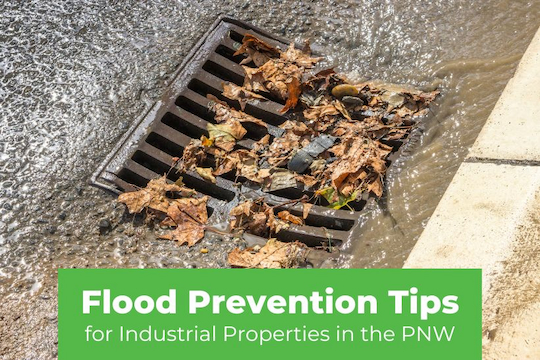Managing stormwater runoff from industrial properties is critical to minimize the potential environmental impacts of flooding and pollution. Implementing effective stormwater management practices requires a comprehensive approach to the situation to address its different aspects.
The following measures provide helpful strategies that can mitigate hazards and preserve your area's water quality and the environment's overall well-being.
1. Plan and Execute Effective Stormwater Management Practices

Effective stormwater management practices are critical ways to reduce industrial stormwater runoff. This strategy involves developing and executing a comprehensive plan to address the specifics of your industrial property. Depending on your property's needs, the program might include installing stormwater detention ponds, retention basins, or infiltration systems to capture and treat runoff.
Additionally, consider implementing some best management practices (BMPs), such as measures to control sediment and erosion, protection for storm drain inlets, and a regular maintenance program for stormwater control structures to reduce the volume of stormwater runoff and pollution from the property.
2. Maintain and Inspect Stormwater Control System Devices
Regular maintenance and inspections are critical in keeping stormwater maintenance devices in optimal condition and functionality. Develop a maintenance schedule to routinely inspect and clean these structures, including detention ponds, swales, and catch basins.
For example, detention ponds are designed to collect all the stormwater and remove sedimentation and pollutants before the rainwater is discharged. However, excessive vegetation, erosion, trash, and other maintenance issues can keep the detention pond from performing as needed.
Clearing out debris, built-up sediment, and vegetation from stormwater management structures and devices helps maintain their capacity to function as intended. It is a crucial way to reduce industrial stormwater runoff. Additionally, routine inspections can identify structural damage early on and reduce the risk of flooding and other system failures.
3. Employ Green Infrastructure Solutions

Green infrastructure can offer effective, sustainable ways to reduce industrial stormwater runoff. This approach involves incorporating natural features into the property's landscaping to handle and treat stormwater. Green infrastructure includes landscape features such as rain gardens, vegetated swales, and green roofs.
These features mimic nature's hydrological processes, which allow water to soak into the ground where it falls, get absorbed by vegetation, or evaporate. They also reduce runoff volume, prevent pollutants from reaching water bodies, and save money through reduced paving, site grading, and reduced or no need for piping and detention facilities.
4. Minimize Impervious Surfaces
Reducing or minimizing the amount of impervious surfaces on an industrial property can help you significantly reduce the amount of runoff. Concrete and asphalt prevent water from soaking into the ground, which increases the property's runoff amount and velocity. Consider implementing strategies that reduce impervious surfaces, such as installing porous pavement.
Alternatively, consider using permeable cement pavers in walkways and parking lots. When stormwater permeates through pervious surfaces, it improves the water's filtration, reduces the volume of runoff from the property, and reduces the pressure on the stormwater management system.
5. Develop a Comprehensive Spill Prevention and Response Plan
Industrial properties often engage in work that involves hazardous substances or pollutants that can put water quality at significant risk if a spill or accident happens. Developing a comprehensive spill prevention and response plan is crucial to keep these hazards from affecting industrial stormwater runoff.
Establish clear guidelines and protocols to prevent spills. Include training for employees on properly handling and storing hazardous materials.
A hazardous substance response plan should also outline effective, prompt response procedures in case of a spill, such as containment, cleanup, and reporting to appropriate parties. By proactively addressing the risk of spills and establishing a well-prepared response plan, you can minimize a spill's impact on stormwater runoff quality.
6. Educate Employees on Stormwater Pollution Prevention

Educating employees can play a critical role in keeping pollution out of stormwater on industrial properties. Consider conducting regular training sessions that educate employees on their role in minimizing runoff and pollution and preventing stormwater pollution.
Include training on properly disposing of hazardous materials, increasing awareness of potential pollutant sources, and keeping clean and well-maintained work areas. By creating a culture that takes responsibility for its part in a clean environment and providing employees with knowledge and appropriate tools, you can ensure their participation and support in reducing your property's stormwater pollution and runoff.
Proactive Plans Make a Difference
Implementing some or all of the above strategies is crucial to significantly reduce your property's industrial stormwater hazards and polluted runoff. Each of these proactive steps counts toward preserving water quality and doing your part to protect the environment.
Reach out to a professional repair storm drain company to inspect your system and assess and remedy any damages or structural issues within your stormwater management system. At Catchall Environmental, we have the engineering skill and years of expertise to maintain and repair your system. Call Catchall today!













